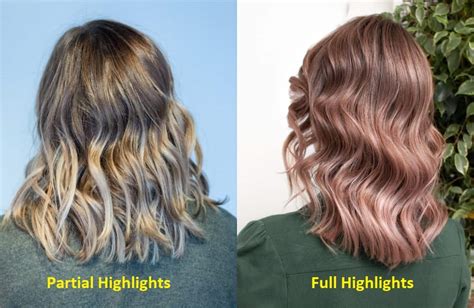Introduction
Hair highlights have dominated the hair industry for decades, adding depth, dimension, and style to countless locks. But with two primary techniques—full highlights and partial highlights—the choice can be daunting. This article delves into the depths of both techniques, exploring their nuances, highlighting their advantages, and unraveling their limitations.

Full Highlights: A Canvas of Illumination
Definition: Full highlights involve the meticulous application of lightener to every individual strand of hair, from root to tip.
Benefits:
* Creates a dramatic, all-over brightening effect
* Adds unmatched depth and dimension to the hair
* Conceals gray hair effortlessly
* Can transform hair color drastically, creating a bold new look
Limitations:
* High maintenance: Requires frequent touch-ups to maintain vibrancy
* Can damage hair if not performed properly
* Time-consuming process, often lasting several hours
Partial Highlights: Strategic Strokes of Radiance
Definition: Partial highlights selectively lighten only some strands of hair, typically focused on specific areas like the crown, face-framing sections, or ends.
Benefits:
* Low maintenance: Requires less frequent touch-ups than full highlights
* Creates a more natural, sun-kissed effect
* Adds subtle depth and dimension
* Less damaging to hair as fewer strands are lightened
Limitations:
* Provides less overall lightening than full highlights
* May not conceal gray hair as effectively
* Can appear patchy if not applied carefully
The Decision Factor: Balancing Needs and Preferences
The choice between full highlights and partial highlights hinges on a combination of personal preferences, hair type, and desired results.
Full Highlights:
- Ideal for those seeking a bold, transformative hair makeover
- Suitable for thicker hair types that can withstand more lightening
- Excellent for concealing gray hair and creating a dramatic color change
Partial Highlights:
- Recommended for those desiring a natural, sun-kissed look
- Suitable for all hair types, including fine or damaged hair
- Ideal for adding subtle dimension and brightening specific areas
Tables Summarizing the Key Differences
| Feature | Full Highlights | Partial Highlights |
|---|---|---|
| Coverage | Every strand | Select strands |
| Lightening | Dramatic | Subtle |
| Gray Coverage | Excellent | Moderate |
| Maintenance | High | Low |
| Damage Potential | Moderate to high | Low |
| Suitable Hair Types | Thicker hair | All hair types |
| Desired Results | Bold transformation | Natural enhancement |
| Cost | Higher | Lower |
Applications Beyond Aesthetics: Therapeutic and Restorative Uses
Beyond their aesthetic appeal, highlights have found innovative applications in the realm of hair restoration. By strategically placing partial highlights, hair stylists can create the illusion of thicker, fuller hair, particularly in areas affected by thinning. This technique, known as “camouflage highlighting,” has become an invaluable tool for individuals with hair loss or alopecia.
Tips and Tricks for Optimal Results
- Consider hair condition: Avoid highlighting heavily damaged hair to prevent further breakage.
- Choose a reputable stylist: Experience and expertise are crucial for achieving desired results without compromising hair health.
- Discuss maintenance: Establish a realistic touch-up schedule to preserve the vibrancy of your highlights.
- Use hair-friendly products: Invest in shampoos, conditioners, and masks specifically formulated for highlighted hair.
Conclusion
Navigating the world of highlights can be a journey of both beauty and nuance. Full highlights offer a bold, transformative effect while partial highlights provide a more subtle, natural radiance. By understanding the intricacies of each technique, you can make an informed decision that best aligns with your hair type, lifestyle, and desired outcome. Remember, the most radiant highlights are those that complement your individual style and enhance your natural beauty.
